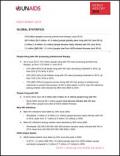What's New
Displaying results 2411 - 2420 of 4052
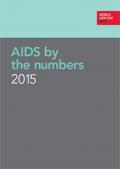
Resource | Data Sheets,
The world has halted and reversed the spread of HIV. The epidemic has been forced into decline. New HIV infections and AIDS-related deaths have fallen dramatically since the peak of the epidemic. Now the response is going one step further—ending the AIDS epidemic by 2030.
In 2014, 36.9 million people were living with HIV. The number of people living with HIV continues to increase, in large part because more people globally are accessing antiretroviral therapy and as a result are living longer, healthier lives. As of June 2015, 15.8 million people were accessing treatment. At the same time, even though new HIV infections have declined, there is still an unacceptably high number of new HIV infections and AIDS-related deaths occurring each year. In 2014, around 2 million people were newly infected with HIV and 1.2 million people died of AIDS-related illnesses.
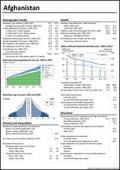
Resource | Data Sheets,
Statistical Yearbook for Asia and the Pacific 2015 - facts and trends at the outset of the 2030 Development Agenda, which provides a first snapshot overview of development trends aligned with the new 2030 Agenda for Sustainable Development. This information will help to ensure better, more informed decision-making and will directly support the efforts of governments, development partners, and the people of Asia and the Pacific to successfully implement the ambitious goals and targets of the 2030 Agenda.
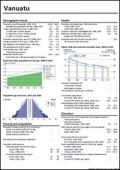
Resource | Data Sheets,
Statistical Yearbook for Asia and the Pacific 2015 - facts and trends at the outset of the 2030 Development Agenda, which provides a first snapshot overview of development trends aligned with the new 2030 Agenda for Sustainable Development. This information will help to ensure better, more informed decision-making and will directly support the efforts of governments, development partners, and the people of Asia and the Pacific to successfully implement the ambitious goals and targets of the 2030 Agenda.
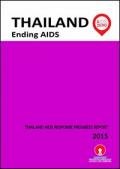
Resource | Publications,
Thailand has joined the commitment to the 2011 UN General Assembly Special Session on HIV to prevent and control the AIDS epidemic and pursue the strategy of 3 Zeroes: (1) Zero HIV new infection; (2) Zero AIDS death; and (3) Zero AIDS stigma and discrimination. The Thailand National Strategic Plan of HIV (2014‐16) has set the 2016 targets to reduce new HIV infection by two‐third, peri‐natal transmission rate less than 2%, AIDS related deaths reduced by half, and discrimination to key populations and people living with HIV reduced by half. The National AIDS Committee (NAC) further approved the policy of ending AIDS epidemic in Thailand by 2030 as the national priority on November 28, 2014, and directed all related agencies at the national and subnational level to mobilize efforts to achieving the objectives. In addition, Thailand has developed key measures and the operational plan for 2015‐19 to support the ending AIDS policy. The measures have applied strategies of test and treat regardless of CD4 level with the focus to most affected areas and populations.
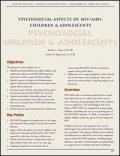
Resource | Publications,
HIV/AIDS takes an enormous physical toll on those infected by the virus as well as those who care for them. However, the psychological toll of the epidemic is just as significant. The psychological and social effects of HIV/AIDS are magnified in young people. Children and adolescents are an ever-growing part of the HIV/AIDS epidemic. In 2004, an estimated 2.2 million children under the age of 15 were living with HIV.

Resource | Publications,
Young people aged 10 to 24 in Asia and the Pacific account for thirty-five percent of new HIV infections in the region. Many young people face difficulties in accessing sexual and reproductive health and rights (SRHR) information, commodities, and services because of the compounding issues that they face. Moreover, many existing HIV programs catering to young people do not always include SRH services or link them to relevant youth-friendly SRH services.
Youth LEAD‘s report, "Our Rights Matter Too: Sexual and Reproductive Health and Rights of Young Key Populations in Asia and the Pacific", provides an overview of the sexual and reproductive health and rights (SRHR) needs, issues, and priorities of young key populations (YKP) in Asia and the Pacific. The report addresses the gaps in knowledge on the SRHR needs of #YKP in the region, offers recommendations based on a regional study, and contributes essential information for policy and advocacy efforts.

Resource | Publications,
UN Women has developed twelve Flagship Programming Initiatives (FPIs) to further deepen its programming and achieve transformative results for gender equality and women’s empowerment. FPIs are high-impact, scalable programmes that will carry the bulk of UN Women’s growth. They build on and supplement, not replace, UN Women’s ongoing programming work.
All FPIs adopt a human rights-based approach by strengthening the voice of women and girls to remove structural barriers for gender equality and women’s empowerment (GEWE). Each FPI is guided by international human rights treaties and contributes towards achieving the outcomes and goals articulated in UN Women’s Strategic Plan. Each FPI is based on a comprehensive theory of change (TOC), which articulates the causal linkages and actions required by national, CSOs, UN, ODA and private partners in order to achieve transformative change in the lives of women and girls.
The role of UN Women in each of these partnerships will be context-specific. In some countries, UN Women will focus on creating a coalition for change while in some other it will play a broader operational role.
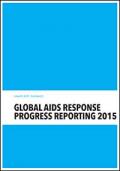
Resource | Guidelines,
The purpose of this document is to provide guidance to national AIDS programmes and partners actively involved in the country response to AIDS on use of core indicators to measure and report on the national response.
These guidelines have been developed to help countries collect data and report on their national HIV response as effectively as possible. In the section “Core indicators for Global AIDS Response Progress Reporting” readers will find pages devoted to each indicator, giving reasons for inclusion and methods for collecting, constructing and measuring the indicator. The indicator’s strengths and weaknesses are also discussed.
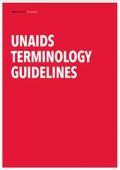
Resource | Guidelines,
Language shapes beliefs and may influence behaviours. Considered use of appropriate language has the power to strengthen the global response to the AIDS epidemic. That is why the Joint United Nations Programme on HIV/AIDS (UNAIDS) is pleased to make these guidelines to Preferred terminology freely available for use by staff members, colleagues in the Programme’s 11 Cosponsoring organizations and other partners working in the global response to HIV.
These guidelines are a living, evolving document that is reviewed on a regular basis. This revision of the 2011 edition has discarded a few terms and added new ones that are relevant to the global response to HIV and commonly used by UNAIDS. The same terms, grouped by subject headings, also are listed at the end of this document.






